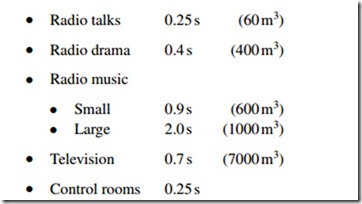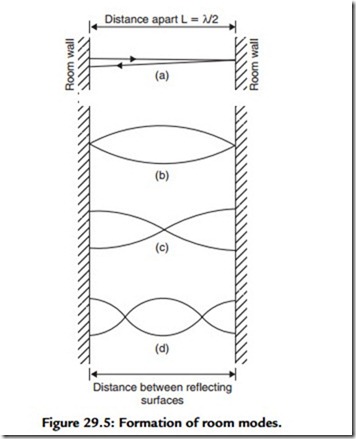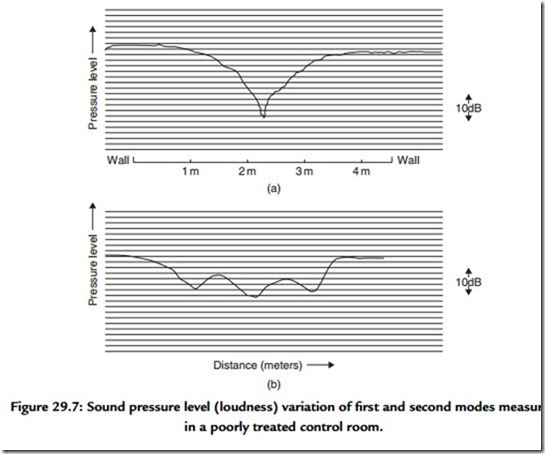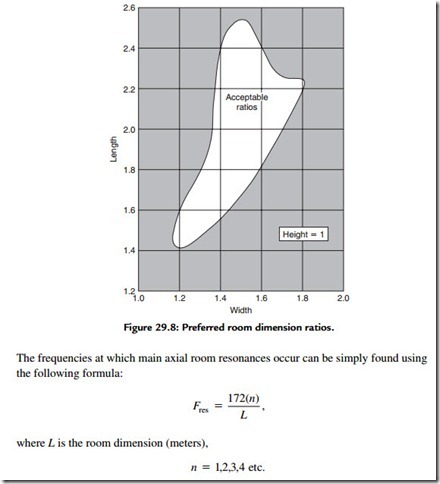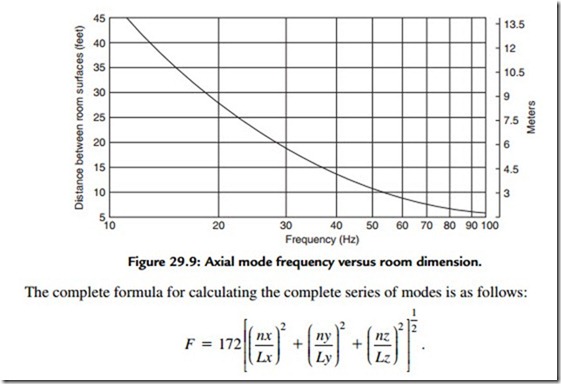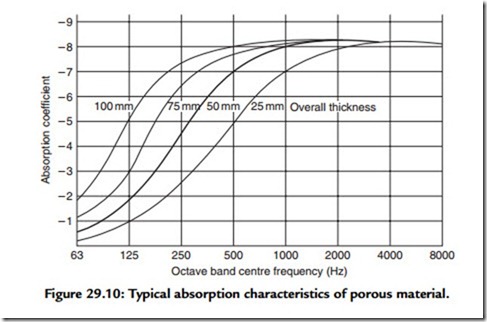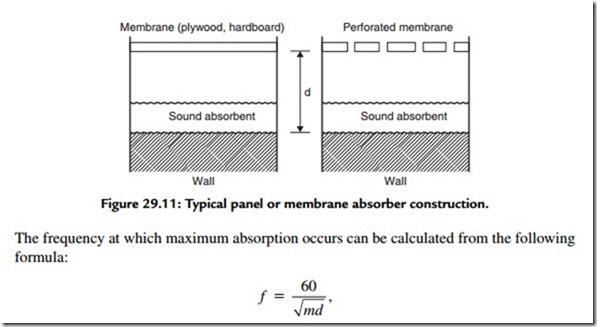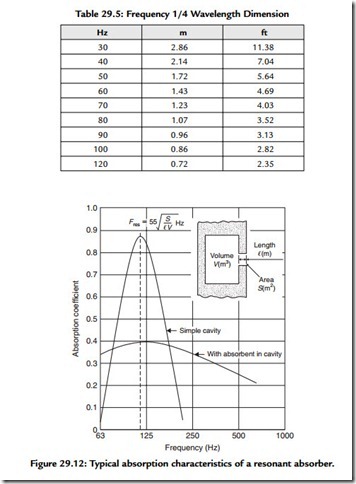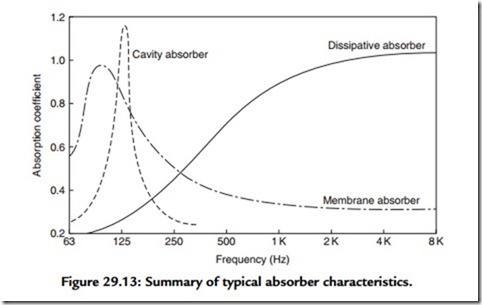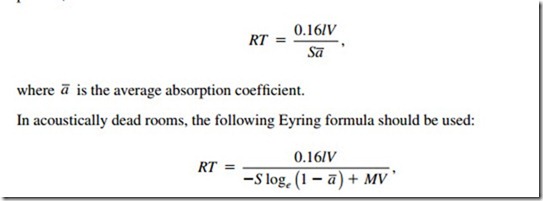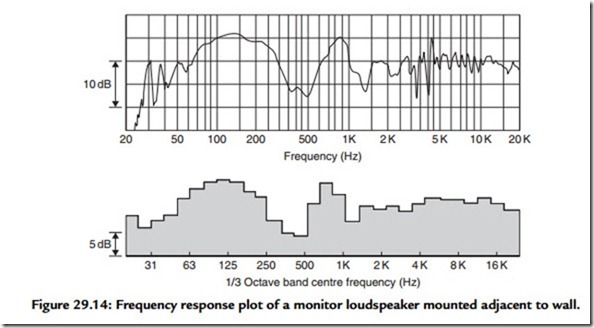Studio and Control Room Acoustics
Today the acoustic response of the control room is recognized as being as equally important, if not more important, than that of the studio itself. This is partly due to improvements in monitor loudspeakers, recent advances in the understanding of the underlying psychoacoustics, and the recent trend of using the control room as a recording space, for example, for synthesizers, whereby better contact can be maintained among musician, producer, and recording engineer.
For orchestral or classical music recording, the studios need to be relatively large and lively, with reverberation times lying somewhere between 1.2 and 2 s depending on their size and use. Pop studios tend to be much more damped than this, perhaps typically varying from 0.4 to 0.7 s.
Broadcast studios would typically have reverberation times as follows:
While it has been recognized for some time now that reverberation time alone is not a good descriptor of studio acoustics, it is difficult to determine any other easily predictable or measurable parameters that are. Reverberation time therefore continues to be used.
Reverberation time is effectively a measure of the sound absorption within a room or studio, etc. Its importance therefore really lies within the way it alters with frequency rather than on its absolute value. It is therefore generally recognized that reverberation time should be maintained essentially constant within tight limits (e.g., 10%) across the audio band of interest with a slight rise at the lower bass frequencies generally being permissible. By maintaining the reverberation time constant, the room/studio is essentially affecting all frequencies equally—at least on a statistical basis. However, in practice, just because a studio or control room has a perfectly flat reverberation time characteristic does not necessarily guarantee that it will sound all right, but it is a good baseline from which to begin.
Studios are generally designed so that they can either be divided up, for example, by use of portable screens or by having their acoustic characteristics altered/adjusted using hinged or fold over panels, for example, with one side being reflective and the other absorptive or by the use of adjustable drapes and so on. Isolation booths or voice-over booths are also frequently incorporated in commercial studios to increase separation. Drama studios frequently have a live end and a dead end to cater for different dramatic requirements and scenes. Recent advances in digital reverberation, room simulation, and effects have, however, added a new dimension to such productions, enabling a wide variety of environments to be electronically simulated and added in at the mixing stage. The same is the case with musical performances/recordings.
It is important not to make studios and control rooms too dead, as this can be particularly fatiguing and even oppressive.
TV studios have to cater for a particularly wide range of possible acoustic environments, ranging from the totally reverberation-free outdoors to the high reverberant characteristics of sets depicting caves, cellars, or tunnels, with light entertainment and orchestral music and singing somewhere in between the two.
As the floor of the TV studio has to be ruler flat and smooth for camera operations and the roof is a veritable forest of lighting, the side walls are the only acoustically useful areas left. In general, these are covered with wideband acoustic absorption, for example, 50-mm mineral wool/glass fiber over a 150-mm partitioned airspace and covered in wire mesh to protect it. Modular absorbers are also used and allow a greater degree of final tuning to be carried out should this be desired.
Absorbers
Proprietary modular absorbers are frequently used in commercial broadcast/radio studios.
These typically consist of 600-mm square boxes of various depths in which cavities are created by metal or cardboard dividers over which a layer of mineral wool is fixed together with a specially perforated faceboard.
By altering the percentage perforations, thickness/density of the mineral wool, and depth of the cavities, the absorption characteristics can be adjusted and a range of absorbers created, varying from wideband mid- and high-frequency units to specifically tuned low- frequency modules that can be selected to deal with any particularly strong or difficult room resonances or colorations, particularly those associated with small rooms where the modal spacing is low or where coincident modes occur.
Resonances
Room modes or Eigentones are a series of room resonances formed by groups of reflections that travel back and forth in phase within a space, for example, between the walls or floor and ceiling.
At certain specific frequencies, the reflections are perfectly in phase with each other and cause a resonance peak in the room frequency response. The resonant frequencies are directly related to the dimensions of the room, the first resonance occurring at a frequency corresponding to the half wavelength of sound equal to the spacing between the walls or floor and so on (see Figure 29.5). Resonances also occur at the harmonics of the first (fundamental) frequencies. At frequencies related to the quarter wavelength dimension, the incident and reflected waves are out of phase with each other and, by destructive wave interference, attempt to cancel each other out, resulting in a series of nulls or notches in the room frequency response. Room modes therefore give rise to a harmonic series of peaks and dips within the room frequency response.
At different positions throughout the room, completely different frequency responses can occur depending on whether a peak or null occurs at a given location for a given
frequency. Variations of 10–15 dB within the room response are quite common unless these modal resonances are brought under control. Figure 29.6 presents a frequency response trace of a monitor loudspeaker in a poorly treated control room.
There are three types of room mode: the axial, oblique, and tangential, but in practice it is the axial modes that generally cause the most severe problems. Axial modes are caused by in and out of phase reflections occurring directly between the major axes of the room, that is, floor to ceiling, side wall to side wall, and end wall to end wall.
Figure 29.7 shows the variation in sound pressure level (loudness) that occurred within a poorly treated control room at the fundamental and first harmonic modal frequencies. Subjectively, the room was criticized as suffering from a gross bass imbalance, having no bass at the center but excess at the boundaries, which is exactly what Figure 29.7 shows, there being a 22-dB variation in the level of the musical pitch corresponding to the fundamental modal frequency and 14 dB at the first harmonic.
When designing a control room or studio, it is vitally important to ensure that the room dimensions are chosen such as not to be similar or multiples of each other, as this will cause the modal frequencies in each dimension to coincide, resulting in very strong resonance patterns and an extremely uneven frequency response anywhere within
The room (studio) dimensions should therefore be selected to give as even as possible distribution of the Eigentones. A number of ratios have been formulated that give a good spread. These are sometimes referred to as golden ratios. Typical values include:
Figure 29.8 presents a graphical check method for ensuring an optimal spread of room resonances.
The graph presented in Figure 29.9 provides a quick method of estimating room mode frequencies.
At low frequencies, the density of room modes is low, causing each to stand out and consequently be more audible. However, at higher frequencies, the density becomes very much greater, forming a continuous spectrum, that is, at any given frequency, a number of modes will occur, which counteract each other. Room modes therefore generally cause problems at low or lower midfrequencies (typically up to 250–500 Hz). While this is primarily due to the low modal density at these frequencies, it is also exacerbated by the general lack of sound absorption that occurs at low frequencies in most rooms.
After determining that the room/studio dimensions are appropriate to ensure low coincidence of modal frequencies, control of room modes is brought about by providing appropriate absorption to damp down the resonances.
Absorber Performance
Sound absorbers effectively fall into four categories:
1. High and mediumfrequency dissipative porous absorbers.
2. Low-frequency panel or membrane absorbers.
3. Helmholtz-tuned frequency resonator/absorber.
4. Quadratic residue/phase interference absorbers/diffusers.
Porous absorbers include many common materials, including such items as drapes, fiberglass/mineral wool, foam, carpet, and acoustic tile.
Figure 29.10 illustrates the frequency range over which porous absorbers typically operate. Figure 29.10 clearly shows the performance of these types of absorber to fall off at medium to low frequencies—unless the material is very thick (comparable in fact to 1/4 wavelength of the sound frequency to be absorbed).
Panel or membrane absorbers (Figure 29.11) therefore tend to be used for low-frequency absorption. The frequency of absorption can be tuned by adjusting the mass of the panel and the airspace behind it. By introducing some dissipative absorption into the cavity to act as a damping element, the absorption curve is broadened. Membrane absorption occurs naturally in many studios and control rooms where relatively lightweight structures are used to form the basic shell, for example, plasterboard and stud partitions, plasterboard or acoustic tile ceilings with airspace above, and so on.
where m is mass of panel in kg/m2 and d is airspace in meters.
The action of porous and membrane type absorbers is often combined to form a single wide frequency band absorber or to extend the low-frequency characteristics of porous materials.
Bass traps are generally formed by creating an absorbing cavity or layer of porous absorption equivalent to a quarter wavelength of the sound frequency or bass note in question. Table 29.5 presents the dimensions required for the range 30–120 Hz.
Figure 29.12 shows basic principles and typical absorption characteristics of a Helmholtz, or cavity, absorber.
The frequency of maximum absorption occurs at the natural resonant frequency of the cavity, which is given by the following formula:
where S is the cross-sectional area of the neck (m2), l is the length of the neck (m), and V is the volume of air in the main cavity (m3).
Often membrane absorbers are combined with cavity absorbers to extend their range. Some commercial modular absorbers also make use of such techniques and, by using a range of materials/membranes/cavities, can provide a wide frequency range of operation within a standard size format. Figure 29.13 illustrates general characteristics of membrane, cavity, and dissipative/porous absorbers.
A newer type of “absorber” is the quadratic residue diffuser. This device uniformly scatters or diffuses sound striking it so that, although individual reflections are attenuated and controlled, the incident sound energy is essentially returned to the room. This process can therefore be used to provide controlled low-level reflections or reverberation enabling studios or control rooms to be designed without excessive absorption or subjective oppressiveness that often occurs when trying to control room reflections and resonances. When designing a studio or control room, the various absorptive mechanisms described earlier are taken into account and combined to produce a uniform absorption/frequency characteristic, that is, reverberation time.
Reverberation and Reflection
Reverberation times can be calculated using the following simple Sabine formula:
![]() where A is the total sound absorption in m2, which is computed by multiplying each room surface by its sound absorption coefficient and summing these to give the total absorption present, or
where A is the total sound absorption in m2, which is computed by multiplying each room surface by its sound absorption coefficient and summing these to give the total absorption present, or
where V is the volume of the room in m3 and M is an air absorption constant.
Achieving a uniform room reverberation time (absorption) characteristic does not necessarily ensure good acoustics; the effect and control of specific reflections must also be fully taken into account. For example, strong reflections can strongly interfere with the recorded or perceived live sound, causing both tonal colorations and large frequency response irregularities. Such reflections can be caused by poorly treated room surfaces, by large areas of glazing, by off doors, or by large pieces of studio equipment including the mixing console itself.
Figure 29.14 illustrates the effect well, being a frequency response plot of a monitor loudspeaker (with a normally very flat response characteristic) mounted near to a reflective side wall.
Apart from causing gross frequency response irregularities and colorations, side wall reflections also severely interfere with stereo imaging precision and clarity. Modern studio designs go to considerable lengths to avoid such problems by either building the monitor loudspeakers into, but decoupled from, the structure and treating adjacent areas with highly absorbing material or by locating the monitors well away from the room walls and again treating any local surfaces. Near field monitoring overcomes many of these problems, but reflections from the mixing console itself can produce comb filtering irregularities. However, hoods or careful design of console-speaker geometry/layout can be used to help overcome this.
The so-called live end dead end approach to control room design uses the aforementioned techniques to create a reflection-free zone, enabling sound to be heard directly from the monitors with a distinct time gap before any room reflections arrive at the mixing or prime listening position. Furthermore, such reflections that do occur are carefully controlled to ensure that they do not cause sound colorations nor affect the stereo image, but just add an acoustic liveliness or low-level reverberant sound field, which acts to reduce listening fatigue and provide better envelopment within the sound field.
